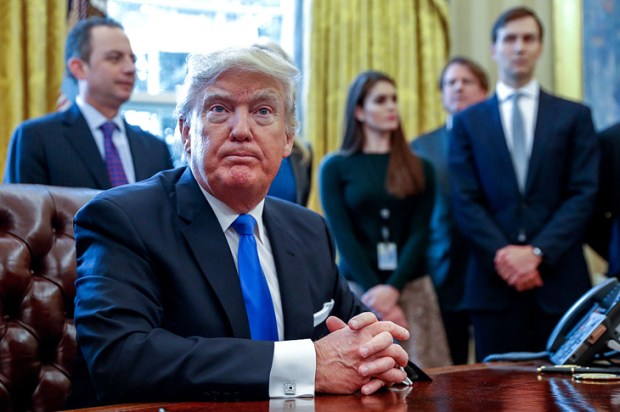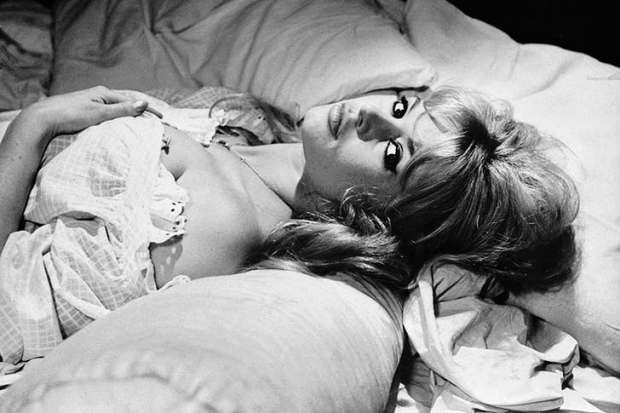When Robert Peston, the economics editor of the BBC, interviewed George Osborne on television in an open-necked shirt with collar awry and a wisp of chest hair on display, he was subjected to a barrage of criticism to which he responded with vigour. It was ‘bonkers’ to suggest that wearing a tie made a journalist serious, he said, or that a tie should be worn out of respect for the interviewee. ‘I didn’t not wear a tie out of disrespect for the chancellor,’ he said. ‘I just didn’t wear a tie because I don’t really like wearing a tie. I think these TV conventions are nuts.’
A report in the Times of this dispute, in which self-appointed British ‘etiquette’ specialists were wheeled on to pass judgment on Peston’s stance, seemed to side with him against what it called the ‘starched shirt and tie’ dress code of Britain, comparing this unfavourably with America’s sartorial informality. Britain, it said, was ‘still enmeshed in its dress codes’, while ‘Steve Jobs, the late chief executive of Apple, always dressed in jeans, trainers and black turtleneck, and Mark Zuckerberg, the founder of Facebook, wears T-shirts and hooded sweatshirts to black-tie events.’
We are in the realm of fantasy here. How could anyone still describe Britain as ‘enmeshed in its dress codes’? All the social pressure in Britain is to dress down, or at least not to wear a tie. Peston is hardly alone. Our role model is Richard Branson, who has said, ‘I often have a pair of scissors in my top pocket to go cutting people’s ties off. It is time to say goodbye to the tie.’ So unfashionable is the tie that it’s not even worn much with dinner jackets any more. If you attend a ‘black-tie’ event you will find that the item usually missing from the uniform is the black tie itself.
The pressure to look informal is exerted from two directions — from the toffs who don’t want to look like toffs and from the non-toffs who don’t want to look as if they are playing the toffs’ game. Thus, David Cameron dresses as informally as he dares, and Labour party leaders tend to agonise before putting on white tie and tails for an event like the Lord Mayor’s Banquet. They tend in the end to go along with convention only because they risk popular disapproval if they don’t (bearing in mind the censure suffered by Michael Foot when, as Labour leader, he wore what looked like a donkey jacket at the Cenotaph ceremony on Remembrance Day).
The British have turned against uniforms of any kind, regarding them perhaps as supportive of the class system and repressive of individuality. The Americans, on the other hand, have no such inhibitions. They may have invented jeans and T-shirts, and have adopted sportswear as their national dress, but they have never stopped loving formal occasions. You can’t be a middle-class American without being regularly called on to wear a black bow-tie, and there are times in Washington DC when the streets seem to be thronged with young men in black ties making their way to some event or other. The Americans go along with the idea that we are prim and stuffy and that they are informal and relaxed, but they are far happier in uniforms than we are.
There has never been much squeamishness in America even about the white tie. Ronald Reagan positively loved it and insisted it be worn at his inaugural balls in 1981 (he wore morning dress for the inauguration itself). And remember Fred Astaire’s ringing endorsement of the outfit in his song from the 1935 film Top Hat:
‘I just got an invitation through the mails,/ “Your presence requested this evening, it’s formal” — / A top hat, a white tie, and tails./ Nothing now could take the wind out of my sails/ Because I’m invited to step out this evening/ With top hat and white tie and tails.’
So we are quite mistaken if we think we are being like Americans in embracing informality. Zuckerberg and the other stars of Silicon Valley may, supported as they are by their vast wealth, feel free to flaunt their non-conformity, but most Americans working in offices still wear ties, and I can’t remember ever seeing a male presenter or interviewer on American television without one. They, unlike Peston, are upholders of Reithian propriety in how broadcasters should dress. They think viewers want them to look humbly respectful, and I think they are probably right.
Got something to add? Join the discussion and comment below.
Get 10 issues for just $10
Subscribe to The Spectator Australia today for the next 10 magazine issues, plus full online access, for just $10.













Comments
Don't miss out
Join the conversation with other Spectator Australia readers. Subscribe to leave a comment.
SUBSCRIBEAlready a subscriber? Log in